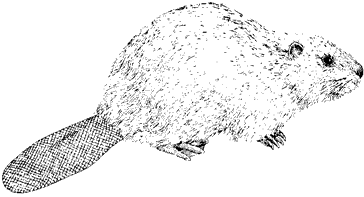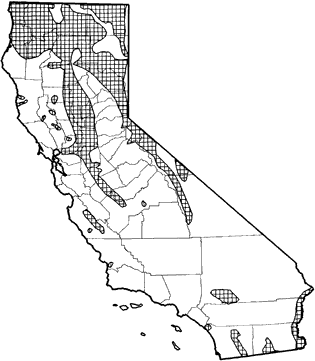
American Beaver
Distribution, Abundance, and Seasonality
Found in streams, ponds, and lake margins in eastern Sierra Nevada and Cascades from Modoc Co. south to Inyo Co., in the northern mountains west to Del Norte Co., and in Central Valley south to Fresno Co. Isolated populations occur in San Bernardino, Riverside, Imperial, San Diego, San Luis Obispo, Monterey, Mendocino, Lake, and Napa cos. Once native to Central Valley and drainages of Colorado, Klamath, and Pit rivers, but decimated by trapping. Subsequently re-established, and introductions have extended original range. Optimum habitats include montane riparian, valley foothill riparian, riverine, lacustrine, aspen, and fresh emergent wetland. Feeds in a variety of other habitats, including valley foothill hardwood, montane hardwood-conifer, mixed conifer, red fir, Douglas-fir, montane chaparral, annual and perennial grasslands, and wet meadow (Grinnell et al. 1937, Tappe 1942, Hall 1960, Jenkins and Busher 1979).

Range Map
Specific Habitat Requirements
Feeding: In spring and summer, prefers grasses, leaves, and aquatic vegetation, such as tules, cattails, and pond lilies. In winter, subsists on bark and cambium of trees. In California, aspen, willow, alder, and cottonwood are preferred. Forages mostly on or near streambanks, felling trees and harvesting branches for winter food. Forages up to 200 m (650 ft) from water. Stores branches in lodge or on pond bottom, held in place by mud. Colony members forage independently (Brady and Svendsen 1981). Cuts a variety of tree sizes, but tends to take smaller trees when foraging far from water (Jenkins 1980). Food preferences vary seasonally. In Sierra Nevada, prefers aspen, taking more willow as aspen is depleted (Hall 1960).
Cover: Retreats into water to avoid disturbance and predators, and constructs dams, where possible, to form ponds. Lodges and bank burrows constructed for shelter. May construct canals to feeding areas, providing cover while traveling .
Reproduction: Builds lodges out of branches and mud, or burrows in muddy banks. The lodge can be 1.8 m (6 ft) high and up to 12 m (40 ft) wide. Kits born in a nest inside lodge or burrow, which have underwater entrances.
Water: Semiaquatic; requires permanent water for reproduction, cover, and riparian and aquatic plant food.
Pattern: Requires permanent, preferably deep, water in rivers, streams, lakes, or ponds, in open to moderately dense riparian forest. In Central Valley, primarily a bank dweller; often does not construct dams and lodges. In montane areas, typical lodge and dam construction is found. Tends to deplete favored food plants in vicinity of colony after several years (particularly in areas where depends on aspen and willow, rather than aquatic vegetation). As a result, colonies may move up or down stream to unexploited areas. This produces a cyclical pattern of exploitation and renewal of habitat.
Species Life History
Activity Patterns: Yearlong, primarily nocturnal activity. Activity begins in late afternoon and may last up to 12 hr per day in spring. In winter, walks over snow to trees, leaving feeding trails. Radio-marked beavers displayed activity rhythms of 26.6 and 29.0 hr; individuals sometimes were asynchronous. Above ice, activity was absent below -10ÁC (14Á F) and increased with temperature (Lancia et al. 1982).
Seasonal Movements / Migration: None.
Home Range: Lives in colony of 1 adult pair, young of the year, and perhaps a few second-year young. At high density, may be considerable inter-colony movement, and some colonies may have more than 2 adults. Colonies in Canada had a home range of 0.8 km (0.5 mi) radius from lodge, or 201 ha (497 ac) (Aleksiuk 1968). Light (1969) estimated home range of a colony in San Bernardino Mts. at 15 ha (36 ac). Densities typically range from 0.4 to 0.8 colonies per km? (0.4 mi?), and may reach 3 per km? (Jenkins and Busher 1979).
Territory: Territories maintained by scent mounds, and were 0.4 km (0.25 mi) radius from the lodge, or 50.3 ha (126 ac) (Aleksiuk 1968). Colonies closer together formed more scent mounds than did more isolated colonies (Butler and Butler 1979). Territorial behavior spaces colonies, but does not prevent depletion of food resources, and starvation in some cases (Bergerud and Miller 1977). Scent mounds may transmit sexual information (Butler and Butler 1979).
Reproduction: Monogamous; mates January through February. Second- and 3rd-yr females may mate later than older females. After gestation of 90-128 days, young born, mostly in May and June. Litter size 1-8, average 3-4. Litter size related to weight of mother, available food, and severity of winters. Young born furred, with erupted incisors and eyes partially open. Lactation lasts 60-90 days. Most young disperse in 2nd yr; may breed in 2nd or 3rd yr. Thus outbreeding is the rule, although parent-progeny matings reported (Svendsen 1980). May live 21 yr or more, but most live less than 10 yr.
Niche: Has a profound effect on habitat. Feeding and constructing dams and lodges affect species composition and abundance of trees, changes water table, creates meadows and ponds, and thereby affects other wildlife species. Positive and negative effects on fish reported (Hill 1982), and known to affect waterfowl, other birds, and small mammals. Cycle of periodic resource depletion and renewal, coupled with movements, may result in a mosaic of habitats spread over a larger area than that occupied at any time. Effects on many species remain to be determined. Preyed upon by coyotes, bobcats, bears, and mountain lions. Infected by Giardia cysts, a potential health hazard to humans (Dykes et al. 1980).
Sources & References
California Department of Fish and Game, 1999.
California's Wildlife, Sacramento, CA.
Written by: V. Johnson, J. Harris, reviewed by: H. Shellhammer, edited by: S. Granholm
Aleksiuk, M. 1968. Scent mound communication, territoriality, and population regulation in beaver (Castor canadensis Kuhl). J. Mammal. 49:759-762. Bergerud, A. T., and D. R. Miller. 1977. Population dynamics of Newfoundland beaver. Can. J. Zool. 55:1480-1492. Brady, C. A., and G. E. Svendsen. 1981. Social behavior in a family of beaver, Castor canadensis. Biol. Behav. 6:99-114. Brenner, F. J. 1967. Spatial and energy requirements of beavers. Ohio J. Sci. 67:242-246. Busher, P. E., R. J. Warner, and S. H. Jenkins. 1983. Population density, colony composition, and local movement in two Sierra Nevada beaver populations. J. Mammal. 64:314-318. Butler, R. G., and L. A. Butler. 1979. Toward a functional interpretation of scent marking in the beaver (Castor canadensis). Behav. Neurol. Biol. 26:442-454. Denny, R. N. 1952. A summary of North American beaver management, 1946-1948. Colo. Game and Fish Dep. Rep. No. 28. 64pp. Dykes, A. C., D. D. Juranek, R. A. Lorenz, S. Sinclair, W. Jakubowski, and R. Davies. 1980. Municipal waterborne giardiasis: an epidemiologic investigation: beavers implicated as a possible reservoir. Ann. Internal Med. 92:165-170. Gard, R. 1961. Effects of beaver on trout in Sagehen Creek, California. J. Wildl. Manage. 25:221-242. Grinnell, J. 1937. Mammals of Death Valley. Proc. Calif. Acad. Sci. 23:115-169. Hall, J. G. 1960. Willow and aspen in the ecology of beaver on Sagehen Creek, California. Ecology 41:484-497. Hensley, A. L. 1946. A progress report on beaver management in California. Calif. Fish and Game. 32:87-99. Hill, E. P. 1982. Beaver. Pages 256-281 in J. A. Chapman and G. A. Feldhamer, eds. Wild mammals of North America. Johns Hopkins Univ. Press, Baltimore, MD. 1147pp. Jenkins, S. H. 1979. Seasonal and year-to-year differences in food selection by beavers (Castor canadensis). Oecologia (Berlin) 44:112-116. Jenkins, S. H. 1980. A size-distance relation in food selection by beavers (Castor canadensis). Ecology 61:740-746 Jenkins, S. H., and P. E. Busher. 1979. Castor canadensis. Mammal. Species No. 120. 8pp. Lancia, R. A., W. E. Dodge, and J. S. Larson. 1982. Winter activity patterns of two radio- marked beaver (Castor canadensis) colonies. J. Mammal. 63:598-606. Light, J. T. 1969. Habitat management plan for beaver, San Bernardino National Forest. U.S. Dep. Agric., For. Serv. Bull. 2620. 33pp. Pearson, C. D. 1977. Population and natural history studies of beavers (Castor canadensis) on Las Flores Ranch, Summit Valley, California. M.S. Thesis, Calif. State Univ., Pomona. 57pp. Svendsen, G. E. 1980. Population parameters and colony composition of beaver (Castor canadensis) in southeast Ohio, USA. Am. Midl. Nat. 104:47-56. Tappe, D. T. 1942. The status of beavers in California. Calif. Dept. Fish and Game, Game Bull. No. 3. 59pp. Townsend, J. E. 1953. Beaver ecology in western Montana with special reference to movements. J. Mammal. 34:459-479.
California Animal Facts | California's Wildlife